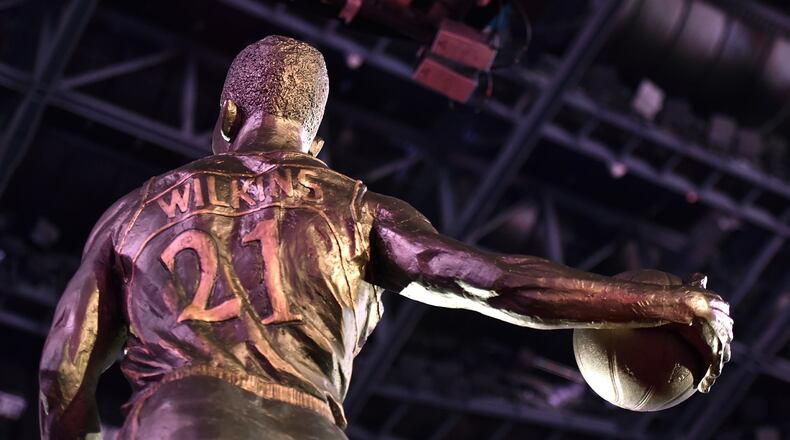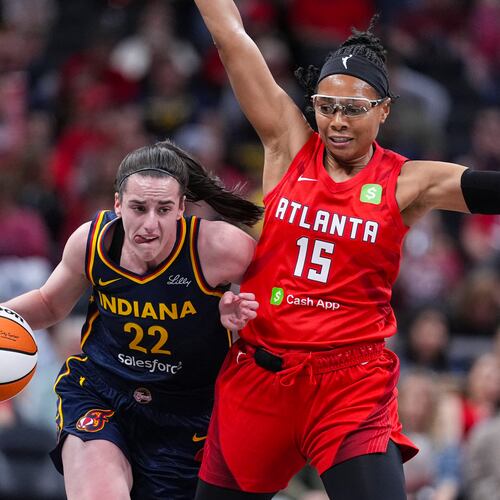Atlanta sports fans can recall many memorable local trades, such as when Dale Murphy left the Braves and later when Fred McGriff arrived. Such as the Falcons trading Brett Favre to the Packers after one season here. Such as David Justice leaving town slightly more than one season after his memorable World Series home run.
While those were significant, here are a few trades involving players who left lasting impressions on the Atlanta teams that either acquired them or traded them – including one player’s arrival AND departure.
These aren’t necessarily the most significant or most memorable trades ever locally, but a group worth looking back on to remember fondly or to lament that they happened.
The entrance and exit of an icon
Dominique Wilkins left the University of Georgia a season early to pursue an NBA career, but with Labor Day weekend approaching in 1982, money was coming between Wilkins and the NBA.
The Utah Jazz selected Wilkins with the No. 3 pick in that year’s draft, but the small-market Jazz weren’t offering him the contract he wanted. In stepped the Hawks.
On Sept. 3, 1982, the Hawks sent two-time All-Star forward John Drew, another player and a reported $1 million to the Jazz for the rights to Wilkins. The trade thrilled the Hawks’ fan base, who were familiar with the man already known as the Human Highlight Film. “Nique” was staying in Georgia.
Drew, a second-round draft choice in 1974 (No. 25 overall) and runner-up for rookie of the year, was a good player. He scored more than 15,000 points in his career (20.7 per game), but never fulfilled his great potential because of off-court decisions. In Wilkins, the Hawks now had someone even more talented.
Fast forward to Feb. 24, 1994. After scoring 23,292 points (26.4 per game) with the Hawks, Wilkins was traded at age 34. The Hawks chose youth, sending their star player and franchise icon to the Clippers, with a first-round draft pick, for Danny Manning, who was 27.
While Wilkins’ shooting touch was diminishing, he was averaging 24.4 points per game that season. After the trade, Wilkins averaged 29.1 in 25 games with the Clippers.
But age soon took its toll. After he finished that season, Wilkins averaged 15.9 points in his remaining 167 games with the Celtics, Spurs and Magic. As for Manning, he already was headed toward free agency and chose not to re-sign with the Hawks. While here, he played in 26 games, averaging 15.7 points.
From unrefined prospect to the Hall of Fame
This was viewed as a run-of-the-mill trade in a pennant race, but it turned out to be much more for the Braves.
The oft-repeated storyline is that a team in a pennant race thinks one player could push it into the postseason, so the team goes looking for that player, usually offering minor league prospects to a team with no illusions of making the playoffs. On Aug. 12, 1987, the Detroit Tigers were in the pennant race, and the Braves were quite a distance from the postseason.
Sometimes it takes only one prospect, which is all it took for the Braves to part with veteran starting pitcher Doyle Alexander, who helped the Tigers win the American League East title after the trade. The prospect was 20-year-old John Smoltz.
Most prospects in such trades don’t eventually find their place in the Hall of Fame, but the Braves saw something in Smoltz. The AJC’s article about the trade described him as someone “known for throwing hard but not always accurately.”
A 22nd-round pick in the 1985 draft, Smoltz was at Double-A in 1987, where he was 4-10 with a 5.68 ERA in 130 innings, in which he recorded 86 strikeouts and 81 walks.
Alexander was almost 37 and nearing the end of his career, and the Braves were in full rebuild mode with a burgeoning farm system. Alexander meant less to the Braves than to the Tigers, and Smoltz represented another pitcher with a live arm to throw in with their mix of prospects.
Alexander retired after the 1989 season. Smoltz made his debut in July 1988, and most Braves fans know the rest of the story. Except for maybe this one tidbit: The player promoted to the active roster to replace Alexander? Tom Glavine.
Making moves to draft quarterbacks
Twice the Falcons have moved up in the NFL draft to the No. 1 spot to draft a quarterback.
In January 1975, they traded offensive tackle George Kunz (himself a No. 2 pick in 1969, behind O.J. Simpson, who had played in five Pro Bowls) and the No. 3 pick in the draft to the Colts for the No. 1 pick and a sixth-round pick. The Falcons used the top pick to select Steve Bartkowski.
In April 2001, they traded Tim Dwight, first- and third-round draft picks in 2001 and a second-round pick in 2002 for the No. 1 pick in 2001, which the Falcons used to take Michael Vick.
With the first of their draft picks, No. 5 overall, the Chargers selected LaDainian Tomlinson, whose career led him to the Pro Football Hall of Fame. Bartkowski and Vick each showed Hall of Fame potential, but fell short.
Bartkowski had a great throwing arm, likely the best of his day, but knee injuries cost him dearly. With each, he was less mobile and more susceptible to further damage. At a time when knee surgeries were more invasive than today, Bartkowski underwent numerous such surgeries, but still led the Falcons to their first three trips to the playoffs (1978, 1980, 1982).
Vick was one of the NFL’s all-time great athletes. While he could throw from the pocket, he often wouldn’t stay there for long, taking off to run faster than any quarterback before him. He, too, possessed great arm strength. Having helped lead the Falcons to the playoffs twice, Vick was leaving fans wondering what was next before his conviction on federal dogfighting charges landed him in prison in 2007.
Neither is the Falcons’ greatest all-time quarterback. That honor belongs to Matt Ryan. Yet, Bartkowski and Vick each tried to stake his claim to that distinction, and early on, the betting lines looked good.
The Pistol trade that misfired
When the Hawks traded Pete Maravich in May 1974, one balm appeared ready to heal the crushed hearts of many Hawks fans – the Jazz were sending the Hawks six players. Trading a player so popular, who in 1996 was voted among the top 50 NBA players of all-time, was justified by the haul coming in return.
The Hawks received two picks from that year’s NBA expansion draft and four over the next three regular NBA drafts. Hawks coach Richie Guerin cited the Louisiana Purchase when trying to find a heist comparable to the one he thought the Hawks had pulled. But things went downhill from there.
As the expansion picks, the Hawks chose forward Bob Kauffman, who had been a three-time NBA All-Star, and guard Dean Meminger, who showed some potential as a role player for the Knicks. Kauffman played one season before he injured a hip and never played again. Meminger played two seasons -- looked mostly like a role player.
As for those college picks, the Hawks took Mike Sojourner at No. 10 overall in 1974. He played three seasons in the NBA, with each succeeding season becoming progressively worse. With the No. 1 overall pick in 1975, Hawks selected the great David Thompson, but all the excitement of that pick fizzled when Thompson signed with the Denver Nuggets of the ABA. (The Hawks held the No. 3 pick because of their own poor record, drafted Marvin Webster and watched him sign with the Nuggets, too.)
Second-round pick Bill Willoughby (1975) was a high school player from New Jersey who had a mediocre career. The 1976 second-round pick went to the Bucks as part of the Hawks’ punishment for signing Julius Erving a few years earlier. The Bucks chose Alex English, who along with Thompson and Maravich are in the Hall of Fame. None of the players who came to the Hawks played above mediocrity.
Nearsighted panic move
The Braves were in a tight division race with the Dodgers in late August 1983, trying to defend their National League West title. Then Los Angeles made a big trade for pitcher Rick Honeycutt, and Braves owner Ted Turner wanted his team to make a corresponding move.
To satisfy the boss, the front office acquired Len Barker.
The chief cost to the Braves was outfielder Brett Butler. He was a fan favorite and prototypical leadoff hitter. Butler collected 2,375 hits in his career, something achieved by only 132 players. In the Atlanta era, only Chipper Jones has more hits while wearing a Braves uniform. Alas, only 238 of Butler’s hits came before he was traded.
The Barker trade was announced as three unidentified players going to the Indians at a later date, but the secret got out quickly. People in the know said that prospects Rick Behenna and Brook Jacoby were two of the three, and then came word that Butler was the third. Soon after, the Braves sent Behenna to the Indians, but intended to keep Butler and Jacoby until after the season. Then Turner talked.
In mid-September, Turner confirmed to Butler that he was part of the trade. Word of that conversation reached commissioner Bowie Kuhn, who was ready to send Butler directly to the Indians. Kuhn gave the Braves the option to pay a $25,000 fine and keep Butler, and they took it.
Barker pitched a perfect game in 1981, but his career was declining sharply by 1983. He pitched here through 1985 and was 10-20 for the Braves.
Meanwhile, the Braves finished three games behind the Dodgers in 1983. The Braves finished 12 behind the Padres the next season, and their slide continued at full speed into the abyss that defined their ’80s – and that daily hole at the top of the batting order didn’t help matters.
About the Author
Keep Reading
The Latest
Featured



